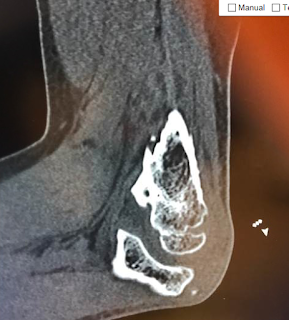Terrible triad injuries are high energy traumatic events to the elbow which are associated with significant soft tissue trauma. The following case illustrates an obese patient who suffered such an injury. The elbow was severely unstable while the weight of the arm was contributing to the instability as well. During surgery the following "inside to outside" algorithm for fixation is used. Fixation begins with the deep structures and we move superficially through a lateral approach. The sequence is the following;
1. Assessment of the coronoid fracture - if large fragment then fixation with sutures or with a screw is indicated
2. Radial head replacement
3. Primary repair of the lateral collateral ligament complex using bone tunnels at the humerus and no anchors. We avoid use of anchors that increase the risk of infection
If the elbow is stable after following the above 3 steps then repair of the medial collateral ligament complex is not indicated. In this case the MCL was ruptured as well however the elbow was stable after the completion of step 3 as illustrated above.
If the elbow is unstable after completion of the above 3 steps then the MCL is repaired. If still unstable then a static external fixator is applied for 6 weeks.
Key points for success of treatment are (a) avoidance of overstuffing of the joint by undersizing the prosthetic radial heads (b) stable fixation of the lateral collateral ligament in the acute setting with a Krackow suturing method. A common mistake is use of large radial prosthetic head "for better stability". Large heads increase the change of subluxation, pain and stiffness. The illustration below indicates the importance of anatomic stable fixation of the LCL using the Krackow method.
trauma films
first reduction was unsuccessful due to inadequate flexion of the elbow and weight of the arm.
Second attempt was successful in close reduction
Undersized the radial head implant is important. One method of assessing potential overstuffing of the joint is the following:
"Incongruity of the medial ulnohumeral joint which becomes apparent radiographically only after overlengthening of the radius by ≥6 mm. Intraoperative visualization of a gap in the lateral ulnohumeral joint is a reliable indicator of overlengthening following the insertion of a radial head prosthesis". We also use the congruency of the proximal radioulnar joint surface line as an indicator of appropriate height of the prosthesis. No step off should be seen.





























